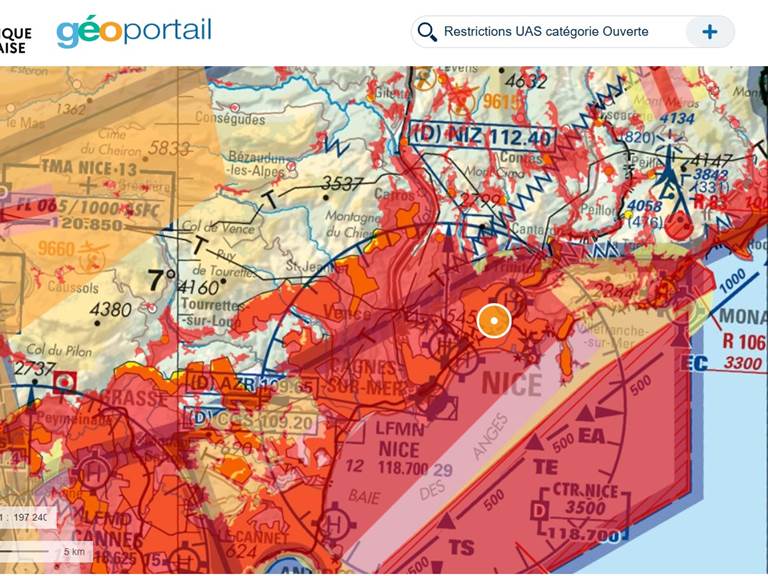The drone photogrammetry training is intended for people wishing to acquire the knowledge necessary for the production of photogrammetric and geo-referenced data by drone. From taking calibration points in the field to analysis and restitution to the client, all the aspects necessary for carrying out photogrammetric surveys are covered during the course of this training. Digital terrain model - DTM, DSM, Orthophotography, elevation plan, dense point cloud, 3D models
The final objective is to be autonomous in programming flights, creating 3D and orthophotographic models, and validating data quality using calibration points.
What is photogrammetry:
Photogrammetry is a technique that uses photography to extract precise measurements and three-dimensional models of objects and environments. Its principle is based on the acquisition of multiple images of the same object or area from different angles, thus making it possible to recreate a three-dimensional model from the visual data collected.
The process begins with the capture of images that are then analyzed by specialized software. These software detect and compare common points between the images to estimate the perspective and distance from which each photo was taken. Using this information, they are able to build an accurate 3D model of the object or area in question. This modeling is often presented in the form of a point cloud, where each point represents a precise position in three-dimensional space.
The applications of photogrammetry are vast and varied. In the field of surveying, it allows the creation of precise and detailed maps, essential for urban planning and land management. In architecture and engineering, it helps to model buildings for inspections and renovation planning. Photogrammetry is also invaluable in archaeology, where it is used to document sites without physical disturbance, to track the evolution and degradation of natural habitats.
Thus, photogrammetry presents itself as a powerful tool, allowing not only to measure and model with great precision, but also to improve the management and preservation of our environment and our cultural heritage.
Applications of photogrammetry:
Here are three of the main applications of photogrammetry that demonstrate its importance and usefulness in different contexts.
Orthomosaic
One of the most common applications of photogrammetry is the creation of orthomosaics. An orthomosaic is a detailed, large-scale map that is generated by stitching together multiple aerial photographs that have been corrected for optical distortions, perspective, and tilts, producing a perfectly scaled image that can serve as an accurate map. This application is crucial for surveying projects, precision agriculture, and urban planning because it provides an accurate and complete overview of a large area.
Volumetry
Photogrammetry is also used to calculate volumes, an essential practice in many industrial sectors. For example, in the mining and building materials sectors, the ability to accurately measure the volume of stockpiles or quarries is essential for inventory management and cost control. By using 3D models generated by photogrammetry, companies can obtain accurate volume measurements without the need for intrusive methods, thereby offering significant savings in time and resources.
3D modeling
Finally, 3D modeling is another important application of photogrammetry. This technique allows the creation of detailed three-dimensional reproductions of objects, buildings, and landscapes. In the field of heritage conservation, for example, 3D modeling by photogrammetry helps in the preservation and restoration of historical monuments. Furthermore, in the entertainment industry, it is used to develop video game environments or film sets that require a high level of detail and realism.
Photogrammetry finds applications in a multitude of fields. Here is a non-exhaustive overview of the main sectors that use this revolutionary technology.
In summary, photogrammetry is a versatile technology that is infiltrating many industries, improving traditional methods of measurement and visualization. Its ability to quickly provide accurate data makes it an invaluable tool for professionals in various industries.
Description of the training:
Photogrammetry is a technique that may seem complex, but by following a few clear steps, you can effectively carry out your own photogrammetry projects. Here are the essential steps to get started:
Mission planning
- Define the goal of your photogrammetric project.
- Choose the area to map or the object to model.
- Plan flight paths or shooting positions for complete and efficient coverage.
Data collection
- Use a drone equipped with a high-quality camera to capture footage.
- Make sure the images overlap considerably (typically 60-80% vertical and horizontal overlap) for accurate reconstruction.
- For more accurate measurements, consider using ground control points (GCPs) that you mark and measure across the study area.
Image processing
- Import your images into specialized photogrammetry software.
- The software will align the images, detect common points and reconstruct the scene in 3D.
- Adjust the settings as needed to optimize the reconstruction.
Creation of the 3D model
- Once the images are processed, the software will generate a point cloud, which can be refined into a 3D model.
- Clean up the model by removing erroneous points or unwanted artifacts.
- Depending on the project, you will be able to export the model in different formats for analysis or for use in other applications.
Data analysis and use
- Use the 3D model for specific analyses, such as volume calculations, inspections, or creating topographic maps.
- Integrate data into larger projects, such as simulations, presentations, or environmental analyses.
By following these steps, you have the basis for carrying out photogrammetry projects, opening the door to a multitude of practical applications in your field of activity.
Prerequisites : Be at least 16 years old
Duration : 3 days (21 hours)
Schedules : Days and times adaptable to demand (even weekends)
Price : €1990
This training is available at all our training locations in France according to the schedule on the first page
Training available in English (quote on request)
Corporate training
This training is usually provided in our centers. However, with solid expertise and a qualified teaching team, we are able to deliver all our training directly within your organization or company.
This personalized approach ensures optimal integration of training content with the specific needs of your organization. By adapting our teaching methods to your professional environment, we aim to optimize learning effectiveness and promote the continuous development of your teams.
This device will simply require a dedicated space during the training period. Chairs, tables and a projection facility will be required.
All our modules are delivered by qualified instructors.
Our remote pilots have technical expertise in the field of drones and are regularly confronted with the reality on the ground.









